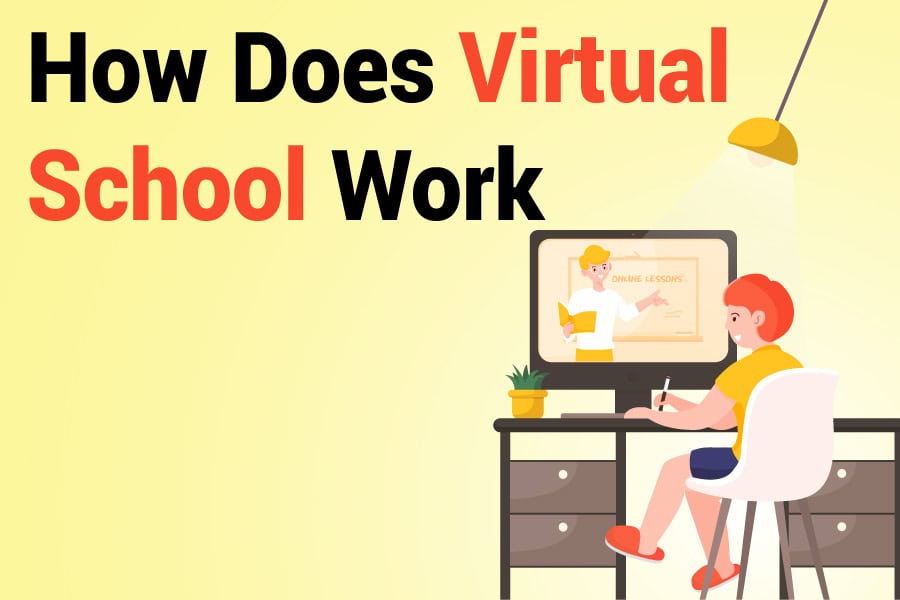With technology transforming the way we learn, virtual schooling has become an increasingly popular alternative to traditional education. But for those new to online learning, a key question arises: [How Does Virtual School Work]? Virtual school offers students the flexibility to learn from anywhere, combining interactive online lessons, assessments, and resources that replicate a traditional school environment, albeit through a digital platform. By understanding the mechanics of virtual school, parents and students can make informed decisions about whether it’s the right educational fit.
In this guide, we’ll explore how virtual school operates, covering essential aspects like lesson structure, teacher interaction, assessments, and the unique benefits it provides. Virtual schooling offers a personalized learning experience, enabling students to progress at their own pace and giving parents greater insight into their child’s education. Whether you’re a parent considering virtual school for your child or a student curious about online learning, this article will help clarify how virtual school works and why it’s a valuable option in today’s educational landscape.
How Does Virtual School Work?
Virtual school operates through an online platform where students attend classes, submit assignments, and take assessments. Lessons are delivered via video lectures, interactive activities, and digital resources, replicating the structure of traditional schooling but offering greater flexibility. Teachers interact with students through virtual classrooms, providing guidance and feedback. Virtual school works well for students who need a flexible schedule or a customized learning pace, making it an effective option for a wide range of learners.
What is Virtual School? A Basic Overview
Virtual school, also known as online school, is an educational system where students learn from home or any remote location rather than attending a physical classroom. Classes are delivered through digital platforms, using a mix of live video sessions, recorded lectures, assignments, and assessments to create a comprehensive educational experience. The curriculum is structured similarly to that of a traditional school, but virtual schooling provides the added advantage of flexibility in location and schedule.
In virtual school, students follow a structured curriculum designed to meet educational standards. They engage with teachers and classmates through online discussions, email, and virtual meeting platforms, creating a collaborative environment despite the physical distance. Virtual schools often provide a range of tools, including interactive lessons, quizzes, and digital textbooks, to support student learning. Some programs are fully self-paced, allowing students to complete lessons as quickly or slowly as they need, while others follow a more structured timetable with live class sessions.
For families seeking a flexible alternative to traditional school or students who require a unique learning pace, virtual school offers a practical solution. It caters to diverse learning styles and often includes options for students to explore additional subjects or advanced coursework.
How Do Virtual Lessons Work? Exploring Class Structure and Delivery
The way virtual lessons are delivered varies based on the program and grade level, but here’s a look at some typical components of virtual school classes:
Live Video Sessions
Many virtual schools conduct live video sessions where students can interact with their teachers in real time. This helps maintain a sense of classroom engagement, allowing students to ask questions and participate in discussions.
Recorded Lectures
Recorded lectures are available for students who prefer to learn at their own pace. These lectures can be paused and replayed, making it easier to review challenging material.
Interactive Learning Activities
Virtual school often includes interactive activities, such as quizzes, educational games, and simulations. These tools engage students and reinforce learning through hands-on experiences.
Assignments and Assessments
Just like in traditional schools, students are required to complete assignments and assessments. Most virtual schools use online platforms where students can upload their work and receive feedback from teachers.
Group Projects and Peer Interaction
Despite being online, many virtual schools encourage collaboration through group projects and discussion boards. This fosters peer interaction and helps build social skills in a digital environment.
Benefits of Virtual School for Students and Parents
The rise of virtual schooling has brought various advantages, making it an appealing option for many families. Here are some of the primary benefits:
- Flexible Learning Schedule
Virtual school allows students to learn on a flexible schedule, making it ideal for families with unique schedules or students engaged in extracurricular activities. - Customized Learning Pace
Students can progress at a pace suited to their individual needs, allowing them to spend extra time on challenging subjects or move quickly through material they’ve mastered. - Safe Learning Environment
Learning from home reduces the risks associated with school commutes and crowded classrooms, offering a safer and more comfortable environment for students. - Increased Parental Involvement
Virtual school allows parents to be more involved in their child’s education, providing insights into what their child is learning and offering support as needed. - Access to Diverse Resources
Virtual schools often include a range of resources, from interactive simulations to specialized programs, which can enrich the learning experience and support diverse learning styles.
How Does Virtual School Grading and Assessment Work?
Assessing students in a virtual school environment involves various methods to ensure they meet academic standards. Here’s a breakdown of how grading and assessment typically work:
- Online Quizzes and Tests
Students complete quizzes and tests online, often through secure platforms that may include timers or randomized questions to ensure academic integrity. - Project-Based Learning
Virtual schools frequently use project-based assignments, which allow students to demonstrate understanding through research projects, presentations, and creative work. - Teacher Feedback and Progress Reports
Teachers provide detailed feedback on assignments and projects, helping students understand their strengths and areas for improvement. Many virtual schools also offer progress reports to track student performance. - Parent and Teacher Conferences
Virtual schools often facilitate regular parent-teacher conferences via video calls, keeping parents informed of their child’s progress and addressing any challenges. - Standardized Testing
In some cases, virtual school students may participate in standardized tests to assess their progress in line with educational benchmarks. These assessments can be conducted online or in designated testing centers.
Who Can Benefit from Virtual School? Ideal Candidates for Online Learning
Virtual schooling is a flexible option, but it’s not the best fit for everyone. Here’s a look at who may benefit most from virtual school:
Self-Motivated Students
Students who are self-directed and motivated to manage their time tend to thrive in virtual schools, as online learning requires a level of independence.
Students with Busy Schedules
Students involved in sports, arts, or other activities that require flexible schedules can benefit from the adaptability of virtual school.
Students with Health Concerns
For students with medical needs or immune conditions, virtual schooling offers a safe learning alternative that minimizes exposure to crowded environments.
Students Seeking Advanced or Specialized Courses
Virtual schools often provide a broader range of courses, including advanced placement and specialized subjects that may not be available in local schools.
Families Seeking More Parental Involvement
Parents who want to be more involved in their child’s education can actively support learning and monitor progress through virtual school platforms.
Final Thoughts
Virtual school provides a modern approach to education, offering flexibility, convenience, and a safe learning environment. By understanding [How Does Virtual School Work], parents and students can make informed decisions about this educational format. Virtual schooling combines structured lessons, interactive activities, and robust assessment methods to provide a comprehensive learning experience. Although it requires self-discipline and motivation, virtual school opens up new possibilities for students to learn independently and explore diverse subjects in a digital setting.
Whether you’re looking for a flexible solution or an alternative to traditional classrooms, virtual school offers a valuable way to achieve educational goals. With continuous advancements in technology, the future of virtual schooling holds exciting opportunities for learners around the world.
FAQ’s
Q. How does virtual school work daily?
A. Virtual school typically involves a mix of live classes, recorded lectures, assignments, and interactive activities. Students log into a digital platform to access lessons, complete work, and interact with teachers.
Q. Is virtual school as effective as traditional school?
A. Virtual school can be equally effective when students are motivated and supported. It offers flexibility and personalized learning, which can benefit many students.
Q. Do students have social interactions in virtual school?
A. Yes, virtual schools often include group projects, online discussions, and collaborative assignments promoting student social interaction.
Q. How is student progress assessed in virtual school?
A. Student progress is assessed through online quizzes, project-based assignments, and teacher feedback. Many programs also offer regular progress reports and parent-teacher conferences.
Q. What equipment do students need for virtual school?
A. Students typically need a computer or tablet with internet access. Some programs may also require headphones, a microphone, and specific software for assignments and assessments.












































Leave a Reply